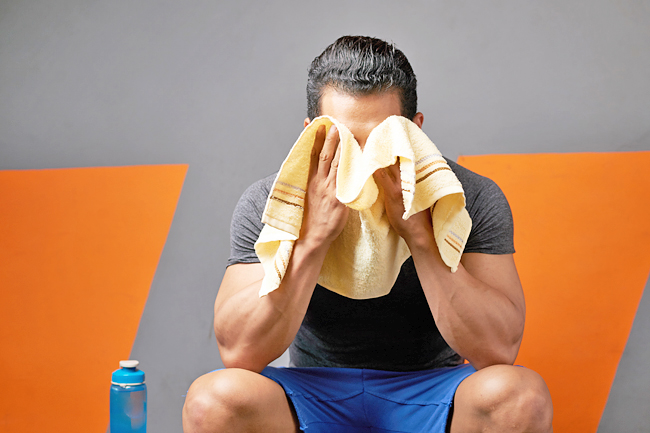Rachel Rabkin Peachman
CNA/THE NEW YORK TIMES COMPANY – Whether you’re a die-hard exercise devotee or just beginning to get into a workout groove, you may worry that coming down with a cold could derail your training routine. Does your runny nose mean you need to skip your exercise session, or could a workout actually do you some good?
Researchers have looked into this very question and have concluded that a mild cold does not always have to sideline you. But there are several key caveats to keep in mind. We talked to the experts behind the research to highlight what you need to know.
DO THE ‘NECK CHECK’
Before you don your workout gear, assess your symptoms carefully. “The most popular advice is to do what’s referred to as the neck check, where if symptoms are above the neck, exercise is probably safe,” said professor of athletic training and chair emeritus of the school of kinesiology Dr Thomas Weidner at Ball State University in Indiana.
If your only symptoms are nasal congestion and a low-grade headache, for example, a light workout shouldn’t make your cold worse.
In fact, a landmark study that demonstrated this was led by Dr Weidner in the 1990s.

In it, 50 young adults were infected with the common cold virus and randomly split into two groups: one that did 40 minutes of moderate exercise every other day for 10 days, and one that didn’t exercise at all.
The researchers found that there was no difference in illness length or severity between the two groups – meaning that working out moderately did not prolong or exacerbate their colds.
Other research done by Dr Weidner has led to similar findings.
If, however, you do have symptoms below the neck, such as a hacking cough, chest discomfort, nausea, diarrhoea or body-wide symptoms like fever, muscle aches or fatigue, “then it’s not a good idea to exercise”, professor of kinesiology Jeffrey Woods at the University of Illinois at Urbana-Champaign, said via e-mail.
MONITOR YOUR SYMPTOMS
Also keep in mind that symptoms can evolve, and what might begin as a runny nose could later become something more serious, like bronchitis or the flu.
Proceed with caution, keep tabs on how you’re feeling and skip the workout if you start to feel worse.
“There’s this myth that you can sweat out a virus, but that is a terrible thing to do,” said professor of biology Dr David Nieman at Appalachian State University and director of the Human Performance Laboratory at the North Carolina Research Campus.
If you’re not feeling well, heavy exercise can exacerbate your symptoms and increase your risk for complications, he said. “It has the potential to really bring you down.”
If your condition does deteriorate, it’s best to rest until the symptoms go away, Dr Nieman said. “Then, gradually get back into the routine,” he added. “Relapse can be common if you get back too quickly and push hard.”
In rare cases, exercising intensely while you’re sick, or even shortly after you’ve recovered, could lead to new or lingering symptoms like exhaustion or unexplained pain. Researchers believe this phenomenon is similar to how some people develop long Covid or chronic fatigue syndrome (also known as myalgic encephalomyelitis, or ME/CFS), which are illnesses that can develop after an acute infection.
“It can be serious for a small percentage of people if they push exercise too hard during the illness or soon thereafter,” Dr Nieman said. “You may enter into this unexplained syndrome, and it’s not worth the risk.”
Another unlikely but possible consequence of working out heavily while battling an upper respiratory infection is myocarditis, or inflammation of the heart muscle, which can cause symptoms such as a rapid or abnormal heart beat, chest pain or shortness of breath.
Researchers aren’t entirely sure how common it is to develop these more serious conditions during or after a viral infection, or why the body reacts in this way. But there is speculation, Dr Nieman said, that the immune system goes into “a strange level” of overdrive that ramps up inflammation.
STICK TO MODERATE WORKOUTS
If you’re confident that your cold symptoms are manageable and you still feel up for exercising, Dr Woods recommended “moderate intensity cardiovascular exercise for 30 to 45 minutes a session”.
A brisk 30-minute walk outside or a low-impact workout on an elliptical machine or stationary bike would be a good option, Dr Nieman said. Dr Woods also noted that lifting light weights is fine. But avoid going to a gym, Dr Nieman said, so you don’t spread your germs to others. He also emphasised that this is not the time to strain yourself or go for a personal best.
If at any point you feel light headed, tightness in your chest or any pain while exercising, consider that your cue to call it quits.
If all goes smoothly, however, you might feel a “psychological boost” after exercising, Dr Weidner said, “and that’s a plus, given the symptoms that might drag a person down”.
Once you’re fully recovered from your cold, slowly ease back into your exercise routine, gradually increasing the length and intensity of your workout. Research shows that when you’re healthy, regular moderate exercise may actually decrease inflammation, improve your immune response and lower your risk of getting upper respiratory infections in the first place.







